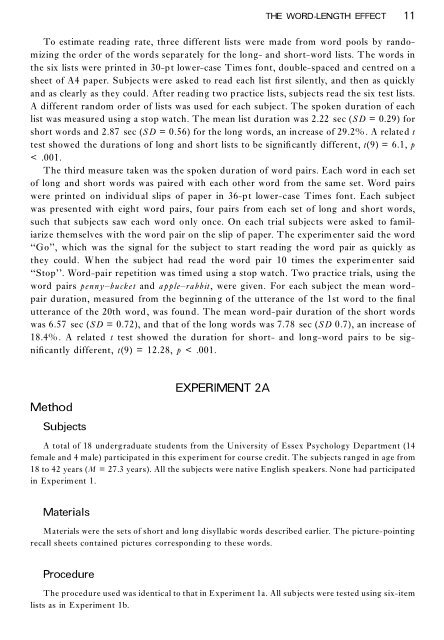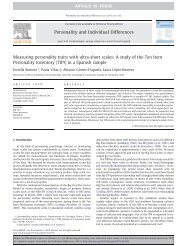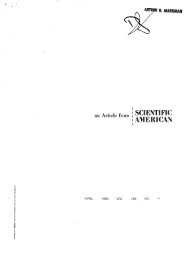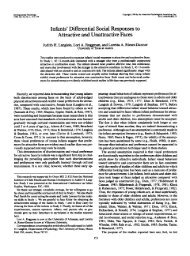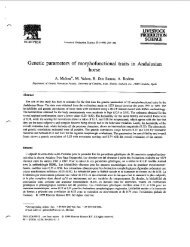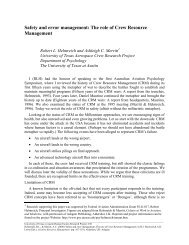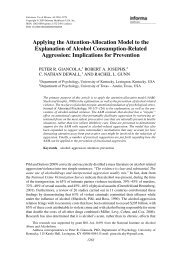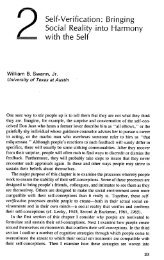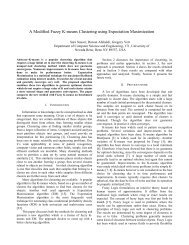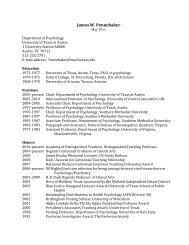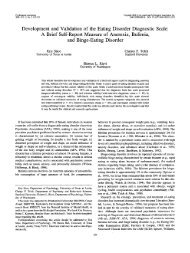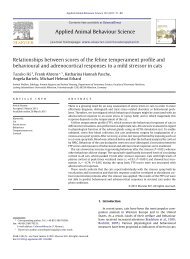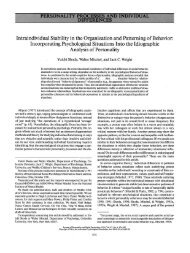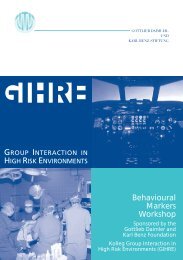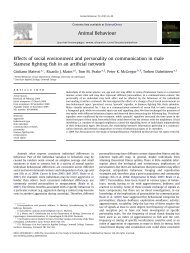The Word-Length Effect and Disyllabic Words (Lovatt
The Word-Length Effect and Disyllabic Words (Lovatt
The Word-Length Effect and Disyllabic Words (Lovatt
You also want an ePaper? Increase the reach of your titles
YUMPU automatically turns print PDFs into web optimized ePapers that Google loves.
THE WORD-LENGTH EFFECT 11<br />
To estimate reading rate, three different lists were made from word pools by r<strong>and</strong>omizing<br />
the order of the words separately for the long- <strong>and</strong> short-word lists. <strong>The</strong> words in<br />
the six lists were printed in 30-pt lower-case Times font, double-spaced <strong>and</strong> centred on a<br />
sheet of A4 paper. Subjects were asked to read each list ®rst silently, <strong>and</strong> then as quickly<br />
<strong>and</strong> as clearly as they could. After reading two practice lists, subjects read the six test lists.<br />
A different r<strong>and</strong>om order of lists was used for each subject. <strong>The</strong> spoken duration of each<br />
list was measured using a stop watch. <strong>The</strong> mean list duration was 2.22 sec (SD = 0.29) for<br />
short words <strong>and</strong> 2.87 sec (SD = 0.56) for the long words, an increase of 29.2%. A related t<br />
test showed the durations of long <strong>and</strong> short lists to be signi®cantly different, t(9) = 6.1, p<br />
< .001.<br />
<strong>The</strong> third measure taken was the spoken duration of word pairs. Each word in each set<br />
of long <strong>and</strong> short words was paired with each other word from the same set. <strong>Word</strong> pairs<br />
were printed on individu al slips of paper in 36-pt lower-case Times font. Each subject<br />
was presented with eight word pairs, four pairs from each set of long <strong>and</strong> short words,<br />
such that subjects saw each word only once. On each trial subjects were asked to familiarize<br />
themselves with the word pair on the slip of paper. <strong>The</strong> experim enter said the word<br />
``Go’’, which was the signal for the subject to start reading the word pair as quickly as<br />
they could. When the subject had read the word pair 10 times the experim enter said<br />
``Stop’’. <strong>Word</strong>-pair repetition was timed using a stop watch. Two practice trials, using the<br />
word pairs penny±bucket <strong>and</strong> apple±rabbit, were given. For each subject the mean wordpair<br />
duration, measured from the beginnin g of the utterance of the 1st word to the ®nal<br />
utterance of the 20th word, was found. <strong>The</strong> mean word-pair duration of the short words<br />
was 6.57 sec (SD = 0.72), <strong>and</strong> that of the long words was 7.78 sec (SD 0.7), an increase of<br />
18.4%. A related t test showed the duration for short- <strong>and</strong> long-word pairs to be signi®cantly<br />
different, t(9) = 12.28, p < .001.<br />
Method<br />
Subjects<br />
EXPERIMENT 2A<br />
A total of 18 undergraduate students from the University of Essex Psychology Department (14<br />
female <strong>and</strong> 4 male) participated in this experiment for course credit. <strong>The</strong> subjects ranged in age from<br />
18 to 42 years (M = 27.3 years). All the subjects were native English speakers. None had participated<br />
in Experim ent 1.<br />
Materials<br />
Materials were the sets of short <strong>and</strong> long disyllabic words described earlier. <strong>The</strong> picture-pointing<br />
recall sheets contained pictures corresponding to these words.<br />
Procedure<br />
<strong>The</strong> procedure used was identical to that in Experiment 1a. All subjects were tested using six-item<br />
lists as in Experiment 1b.


